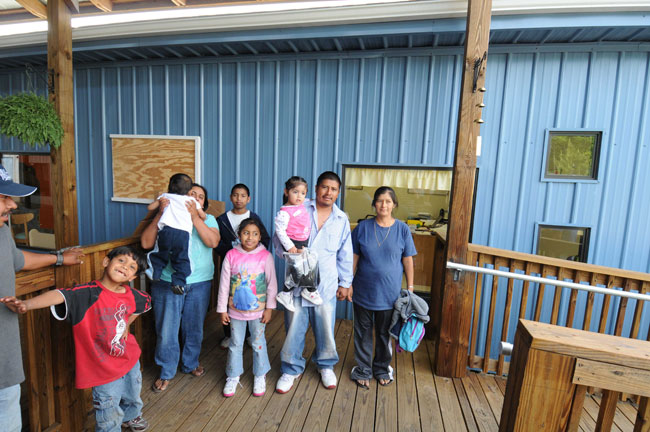East Coast Migrant Head Start Project: Child Care Centers

Photo © Ted Hoffman

Photo © Ted Hoffman

Photo © Ted Hoffman

Photo © Ted Hoffman

Photo © Ted Hoffman

Photo © Ted Hoffman

Photo © Ted Hoffman

Photo © Ted Hoffman








Architects & Firms
Southeastern U.S.
Each year, countless migrant laborers travel from Mexico, Honduras, Haiti and other economically challenged countries to rural areas in the Southeastern U.S. to harvest fruits and vegetables, often with children in tow. In many cases, parents are unable to put their infants and toddlers in day care and are forced to take them into the fields.
Enter the East Coast Migrant Head Start Project (ECMHSP), a federally funded nonprofit organization created in 1974. Each year, the group provides free child care to roughly 5,000 migrant workers’ children, ages six weeks to five years. Often the program is operated out of old schools and churches.
In 2006, ECMHSP received funding to construct purpose-built child care facilities in four different locations, and later received funding for two more. To design the buildings, it turned to Ted Hoffman, an architect based in Labelle, Florida. Over the past 30 years, Hoffman, who only accepts socially responsible commissions (he cites Samuel Mockbee as a role model), has designed more than two dozen day-care centers. “I do a few projects a year that are special to me,” he says, “and I get to spend time designing and building. It’s allowed me to do what makes me happy.” His design process is rather old-fashioned, Hoffman notes: “I draw by hand. I never learned how to use AutoCAD.”
Given his background and beliefs, Hoffman was happy to take on the Head Start project. His task was to create a roughly 15,000-square-foot complex that could be replicated at each location (one in North Carolina, one in South Carolina, two in Alabama, and two in Florida). There were two major considerations: cost and the possibility that the centers would be moved in the future because of changes in crops or land ownership. Given these concerns, Hoffman opted to use a flexible, hybrid approach: prefabricated modular units linked together with custom-built, covered wooden decks. Head Start didn’t give the architect much direction. “It was Ted more or less presenting to us his vision, and us going, ‘Wow,’” explains John Menditto, the organization’s general counsel, who worked closely on the project.
The complex is intended to be welcoming and dynamic. At each site, four to six steel modules sit up to 20 feet apart at various angles and wrap an outdoor play area. Each 72- by 28-foot module contains three classrooms, with the exception of one designated for offices and a kitchen. To jazz up the units, Hoffman worked with the manufacturer, Florida-based Affordable Structures, to incorporate custom features, such as sloped ceilings and large windows placed low so kids could peer out. “When you’re inside them,” he says, “there’s no way you think they’re modular construction.” Delivered and set up, the units cost $80 per square foot. “It was important to me to make the dollars go as far as I could,” Hoffman notes.
Another critical aspect: ensuring the units could withstand a major storm. Hoffman employed a footing suitable for a stick-built building of the same size. Thus, the units have been certified by the State of Florida to withstand winds up to 150 miles per hour.
The project’s most interesting feature is the elevated wooden decking that doubles as corridors and gathering areas. “In my work, I’ve always been interested in the space that occurs between buildings,” says Hoffman. Although each site varies slightly, the steel-clad canopies rise 12 to 20 feet above the deck and are supported by an exposed wooden truss. Clerestorylike openings in the canopy structure usher in natural light and air (and some rain, unfortunately). The decks have become an important amenity for both kids and parents. Hoffman has even seen piñatas hanging from the truss.
ECMHSP has completed all six centers, with the final one opening this past December. When asked how people feel about the buildings, Menditto says they’re not thinking about design. “These families have so little,” he says. “They’re just very grateful to have a safe place for their children. It’s as fundamental and as simple as that.” For Hoffman, the centers embody his life’s mission. “I hope to never retire,” he says. “Get a job you love, and you’ll never work another day in your life.”









